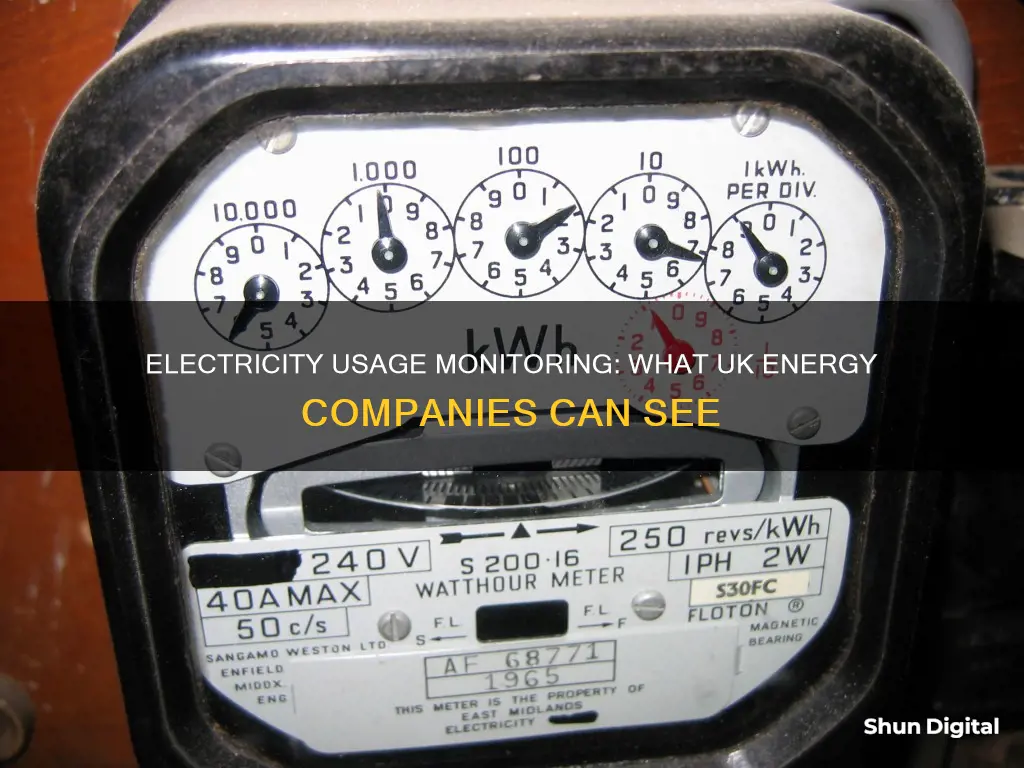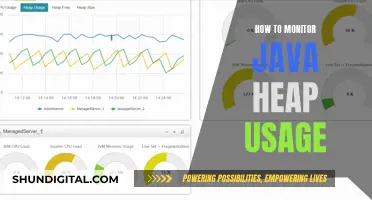
Energy monitors are devices that allow you to track your electricity usage in real-time, helping you identify opportunities to reduce electricity usage and save money on your bills. They are small tabletop devices that show how much money your energy consumption is costing you and can be easily installed by plugging into a power source. Energy monitors differ from smart meters, which automatically send accurate readings to your energy supplier to ensure precise billing. While smart meters are currently being offered as part of a nationwide scheme in the UK, energy monitors are a complementary tool for consumers who want to take control of their energy habits and make more informed choices about their usage and spending.
| Characteristics | Values |
|---|---|
| Purpose | To monitor electricity usage and adjust consumption patterns |
| Benefits | More control over energy usage; can save money; can reduce environmental footprint |
| Types | Whole house energy monitors; plug-in energy monitors; smart meters; prepayment meters |
| Features | Real-time monitoring; historical data; portable display; wireless connectivity; budget targets |
| Cost | £30-£40 for standalone energy monitors; £30-£100 for electricity usage monitors |
| Limitations | Data taken from a sensor, not directly from the electric meter; doesn't automatically send data to suppliers |
What You'll Learn

Energy monitors vs smart meters
Energy monitors and smart meters are both devices that allow users to monitor their energy usage. However, they have several key differences, which are important to understand when deciding which option is best suited for your needs.
Energy Monitors
Energy monitors are devices that allow users to monitor and manage their electricity usage data, including electricity consumption, current, voltage, and power. They are designed for energy management and can be used in residential, commercial, and industrial settings. Energy monitors provide real-time information on electrical data, such as kilowatt-hour (kWh) consumption, and can also provide insights for maintaining electrical safety. They come in various types, including energy monitors with external current sensors, smart energy sensors, and smart plugs, which vary in price. Energy monitors are typically installed by property owners or professional electricians, and their installation locations can be flexible.
Smart Meters
Smart meters are modern replacements for traditional gas and electricity meters. They measure energy use in real-time and automatically send this information to the energy supplier, eliminating the need for manual meter readings. Smart meters are mainly designed for billing purposes and allow energy suppliers to remotely read the meter and bill customers accordingly. They are usually installed in the same location as traditional electricity and gas meters and tend to be larger in size than energy monitors. Smart meters usually come with a smart meter monitor, a small display that shows how much energy is used in real-time and how much it is costing. They can also provide real-time data on how much energy is used, but they are designed to update less frequently than energy monitors. Smart meters are provided by the energy supplier free of charge, but the cost is eventually passed on to consumers through their energy bills.
Key Differences
While both options offer benefits in optimising electricity consumption, there are several key differences to note:
- Purpose: Energy monitors are primarily designed for energy management, while smart meters are mainly designed for billing purposes.
- Data Granularity: Energy monitors provide more detailed insights into the energy consumption of individual circuits or appliances, while smart meters only provide household or overall property usage data.
- Data Updates: Energy monitors provide real-time data, which is critical for energy management and identifying issues with excess power consumption. In contrast, smart meters are designed to update less frequently, typically every 30 minutes or every 24 hours.
- IoT Features and OTA Upgrades: Energy monitors often come with advanced IoT features and the ability for over-the-air (OTA) upgrades, allowing for remote access and control through smartphone apps or web portals. These features are not typically found in smart meters.
- Installation: Energy monitors can be installed by property owners or electricians, and their installation locations are flexible. Smart meters, on the other hand, are usually installed by specially trained technicians appointed by the energy supplier.
In conclusion, both energy monitors and smart meters have their advantages and are suitable for different purposes. Energy monitors are ideal for those seeking detailed energy usage data and real-time insights for energy management. On the other hand, smart meters are useful for those who want automatic billing based on real-time energy usage data and access to dynamic pricing.
Colleges Monitoring Student Online Activity: Is Privacy Invasive?
You may want to see also

How energy monitors work
Energy monitors are small tabletop devices that show you how much money your energy consumption is costing you. They are usually placed near a power cable coming from an appliance and provide an instant measurement of how much you're paying for electricity per hour.
There are two main types of energy monitors: whole-house energy monitors and individual-device monitors. Whole-house energy monitors are hand-held screens that you can take anywhere in your house. They communicate with a small separate unit that clips onto your electricity meter and tell you how much electricity you're using in real-time. Individual-device monitors, on the other hand, gauge the real-time electrical use of individual appliances and other electrical devices.
Energy monitors usually include a sensor, transmitter, and a handheld or portable display. The sensor is attached to the main line of electricity that goes into your meter. The transmitter then sends regular updates on your energy usage back to the monitor, which is displayed on the screen in kWh, cost, or carbon emissions.
Energy monitors are not a substitute for your energy meter but rather provide additional information to help you manage your consumption. They can help you identify which appliances are consuming the most energy and encourage you to change your behaviour to reduce your energy bills.
Battery-Sapping Security Apps: Monitor Your Usage
You may want to see also

The cost of energy monitors
Energy monitors are small devices that measure how much energy you are using in your home. They are a great way to find out the breakdown of the electricity your appliances use and reduce bills. Energy monitors usually come in two parts: a sensor that clips onto the power cable of your electricity meter, and a visual display unit.
Standalone energy monitors that are not connected to a smart meter typically cost around £30 to £40. These monitors are easy to install and can help you keep track of your energy usage and make more sustainable choices.
It is important to note that some energy suppliers may offer an energy monitor or a phone app to track your energy usage if you have a smart meter. These options may be more cost-effective than purchasing a separate energy monitoring device.
Monitoring Children's Internet Usage: Parenting in the Digital Age
You may want to see also

Energy monitor accuracy
Energy monitors are devices that record your energy consumption, allowing you to make changes to your electricity usage and reduce your electricity bills. They are available in different forms, such as energy monitoring plugs, smart meters, and whole-home smart energy monitors. While they provide valuable insights into the energy consumption of your appliances, it is important to understand their accuracy and limitations.
Types of Energy Monitors
Energy monitors can be categorised into three main types:
- Handheld Monitors: These consist of a sensor and a digital display unit. The sensor is clipped to the power cable connected to your electricity meter, detecting electricity usage and transmitting data wirelessly to the handheld unit.
- Online Monitors: Similar to handheld monitors, but instead of a dedicated display unit, you access the information on your smartphone or tablet.
- Plug-in Monitors: These monitors are plugged directly into a wall socket and measure the energy consumption of individual appliances. Multi-socket monitors can accommodate multiple appliances simultaneously.
Accuracy of Energy Monitors
The accuracy of energy monitors depends on the type and quality of the device. Here are some factors that affect their precision:
- Data Source: Handheld energy monitors collect data from a sensor attached to the power cable, not directly from the electricity meter. This can lead to slight inaccuracies, especially when measuring lower consumption levels, typically below 100 watts.
- Device Type: Whole-home energy monitors are better suited for tracking overall energy consumption. They may not provide accurate measurements for individual devices, especially those with lower power consumption.
- Price: In general, higher-priced energy monitors tend to offer more accurate readings. More expensive models may include advanced features, such as selecting the display format (£, CO2 generation, or kWh) and isolating specific appliances for targeted energy monitoring.
- Plug-in Monitors: These monitors are generally more accurate for measuring the energy consumption of individual appliances. They are often recommended for this specific purpose.
- Smart Meters: Smart meters are considered highly accurate for monitoring gas and electricity usage. They send data directly to your energy supplier, ensuring precise billing.
Best Practices for Accurate Readings
To ensure the most accurate readings from your energy monitor:
- Sensor Placement: Ensure the sensor is securely clipped to the power cable of your electricity meter. A stable connection is crucial for accurate data transmission.
- Display Unit Proximity: Keep the display unit close to the sensor to maintain a strong wireless connection.
- Regular Calibration: Calibrate your energy monitor periodically by comparing its readings to those of your electricity meter. This helps identify any discrepancies and adjust the monitor accordingly.
- Battery Backup: For plug-in meters that require a battery, opt for those with a battery backup to prevent data loss in case of a power outage.
- Appliance Isolation: For accurate measurements of individual appliances, ensure only one device is turned on at a time when conducting tests. This isolation helps attribute the energy consumption accurately.
In conclusion, energy monitors are valuable tools for understanding your energy usage and making informed decisions to reduce consumption and save costs. While they provide insightful data, it is important to be aware of their limitations in terms of accuracy, especially for handheld and whole-home monitors. By choosing the right type of energy monitor, ensuring proper setup, and following best practices, you can maximise the accuracy of your energy consumption readings.
Monitoring Linux CPU Usage: A Comprehensive Guide
You may want to see also

Energy-saving alternatives
Energy monitors are a great way to track your electricity usage and identify areas where you can cut down on costs and environmental impact. They are small, tabletop devices that show you how much your energy consumption is costing you and how much you're saving when you change your energy usage. Energy monitors are not a substitute for your energy meter but rather a complementary tool to help you manage your consumption.
There are two types of energy monitors: whole-house energy monitors and plug-in monitors. Whole-house energy monitors are hand-held screens that communicate with a separate unit that clips onto your electricity meter and tell you how much electricity you're using in real-time. Plug-in monitors are used between a socket and the plug of the device being measured and are good for working out the power consumption of individual devices.
Energy monitors vary in price and features, with some providing detailed data about electricity usage for each electrical circuit in your house and even monitoring solar energy production. Basic energy monitors can be found for as little as £13, while more advanced monitors with remote access can cost upwards of £80.
Smart meters are another alternative to monitor your energy usage. These are installed by your energy supplier and measure overall electricity and gas usage in your home. The data is then sent to your energy supplier to provide accurate bills. Smart meters are currently being rolled out across the UK as part of a nationwide scheme to help households understand their energy spending.
If you're looking for a more budget-friendly option, you can also use smart plugs. Smart plugs allow you to monitor and control the energy usage of individual appliances, providing real-time energy tracking and remote control via a smartphone app. They are a great way to save money by using your appliances more efficiently and only when needed.
- Ensure your home is adequately insulated, including loft insulation.
- Make sure your home is draught-proofed by checking for escaping heat around doors and windows.
- Consider investing in energy-efficient appliances, switching to LED lightbulbs, and installing a programmable thermostat.
Monitoring Employee Internet Usage: Company Surveillance Exposed
You may want to see also
Frequently asked questions
An electricity usage monitor is a device that allows you to track your energy consumption in real-time and make changes to reduce energy waste and save money on your bills.
Electricity usage monitors typically have a sensor that attaches to the main electricity line going into your meter. This sensor sends updates on your energy usage to a display screen, which can be placed anywhere in your home. The data is usually displayed in kilowatt-hours (kWh), cost, or carbon emissions.
Smart meters are modernised versions of standard meters that can measure electricity and gas usage. They send usage information directly to your energy supplier to ensure accurate billing. Electricity usage monitors, on the other hand, only measure electricity usage and do not send data to your supplier. They are meant to complement your energy meter, not replace it.
Electricity usage monitors provide valuable data that can help you identify power-hungry devices, track peak and off-peak usage, and eliminate phantom loads (passive power consumption by devices on standby). They give you real-time insights into your energy usage, helping you make informed decisions to reduce electricity costs.
Electricity usage monitors do not automatically reduce your energy consumption or bills. You must proactively implement changes to your energy habits based on the information provided. Additionally, they may be less accurate at lower consumption levels, and they cannot measure the usage of devices without plugs, such as alarm systems, lighting circuits, or cookers.







